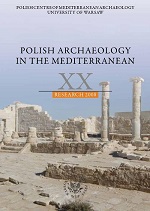NUMISMATIC FINDS FROM KOM EL-DIKKA (ALEXANDRIA), 2008
NUMISMATIC FINDS FROM KOM EL-DIKKA (ALEXANDRIA), 2008
Author(s): Adam JeglińskiSubject(s): Archaeology
Published by: Wydawnictwa Uniwersytetu Warszawskiego
Keywords: Alexandria; Kom el-Dikka; 3rd century AD Roman tetradrachms; Diocletian; Area F
Summary/Abstract: A total of 116 bronze coins was found in a layer of ashes and debris associated with the functioning of the late Roman baths in Area F of the Kom el-Dikka site. This layer constituted fill covering kilns used to produce lime for the construction of the baths. The kilns were located on top of residential ruins, the destruction of which has been dated to the end of the 3rd century AD . Identifiable specimens comprised issues of emperors from the Second Tetrarchy period, the Constantine dynasty, Arcadius and the 6th and 7th century, corresponding well with the known dating of the bath complex. Among the coins were 33 tetradrachms struck between the reign of Philip the Arab and Diocletian, in the latter case before the monetary reform of AD 297. The chronological structure of this set is typical of hoards from the middle of the last decade of the 3rd century AD . Bulk of the pottery uncovered in the same context as the tetradrachms dates back to 4th and even 5th century, which suggests that the hoard was displaced somehow from its original 3rd century location. It is likely that fill from the early Roman houses was used for filling up and levelling the construction site. The hoarded coins may have been moved together with the earth and consequently became dispersed over a small area of a few ares in their secondary deposition context. Coin finds from the early Roman layers included a drachma of Septimius Severus from the fill of the ruins of an early Roman house and coins of Trajan and Hadrian from its occupational levels.
Journal: Polish Archaeology in the Mediterranean
- Issue Year: 2011
- Issue No: XX
- Page Range: 70-80
- Page Count: 11
- Language: English

